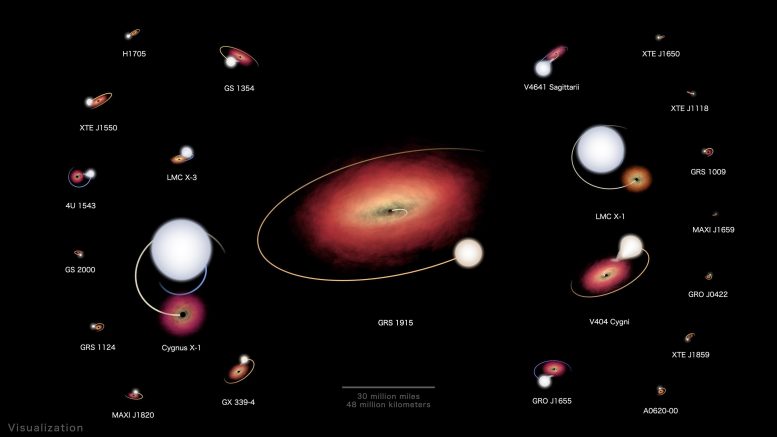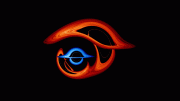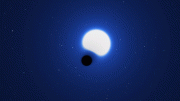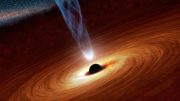
Learn more about the best-known black hole systems in our galaxy and its neighbor, the Large Magellanic Cloud. Credit: NASA’s Goddard Space Flight Center and Scientific Visualization Studio
This visualization shows 22 X-ray binaries in our Milky Way galaxy and its nearest neighbor, the Large Magellanic Cloud, that host confirmed stellar-mass black holes. The systems are depicted at the same physical scale, and their orbital motion is sped up by nearly 22,000 times. The view of each binary replicates how we see it from Earth. The colors of the stars range from blue-white to reddish, representing temperatures from 45% cooler to 5 times hotter than our Sun.
While the black holes appear on a scale reflecting their masses, all are depicted using spheres larger than their actual size. Cygnus X-1, with the largest companion star shown, is the first black hole ever confirmed and weighs about 21 times more than the Sun. But its surface – called its event horizon – spans only about 77 miles (124 kilometers). The enlarged spheres also cover up visible distortions produced by the black holes’ gravitational effects.
In most of these systems, a stream of gas flows directly from the star toward the black hole, forming around it a broad, flattened structure called an accretion disk. In others, like Cygnus X-1, a massive star produces a thick outflow called a stellar wind, some of which becomes swept up by the black hole’s intense gravity. Gas in the accretion disk heats up as the material slowly spirals inward, glowing in visible, ultraviolet, and finally X-ray light. Because the accretion disks reach even higher temperatures than the stars, they use a different color scheme.
Learn more about the best-known black hole systems in our galaxy and its neighbor, the Large Magellanic Cloud. This visualization presents 22 X-ray binary systems that host confirmed black holes at the same scale, with their orbits sped up by about 22,000 times. The view of each system reflects how we see it from Earth. Star colors ranging from blue-white to reddish represent temperatures from 45% cooler to 5 times hotter than our Sun.
In most of these systems, a stream of matter from the star forms an accretion disk around the black hole. In others, like the famous system called Cygnus X-1, the star produces a hefty outflow that is partly swept up by the black hole’s gravity to form the disk. The accretion disks use a different color scheme because they sport even higher temperatures than the stars.
The largest disk shown, belonging to a binary called GRS 1915, spans a distance greater than that separating Mercury from our Sun. The black holes themselves are shown larger than in reality using spheres scaled to reflect their masses.









At the center of ever black hole mass is conserved as space and this space rushibg outeard is making the universe bigger. Pure mass, pure space. And pure energy are unstable. Our understanding of the universe is the interaction of these three interchangeable components. Eventually once all the mass is conserved as space, unstable space will be conserved as energy. Cycle starting over again.